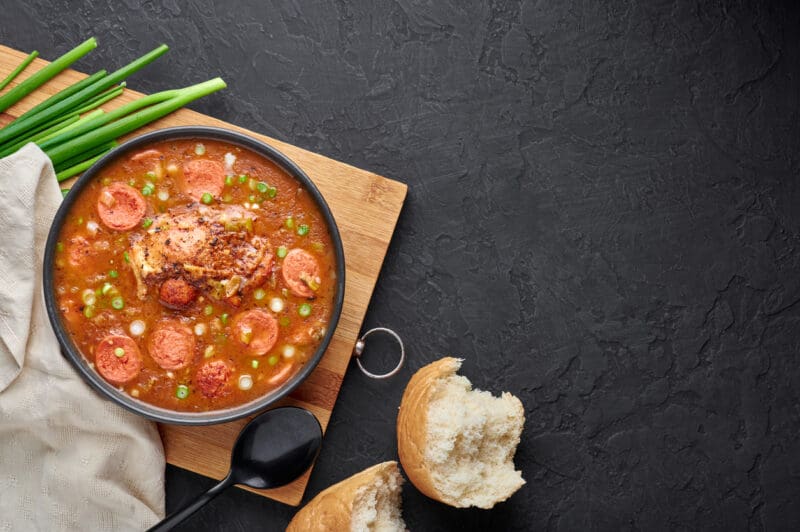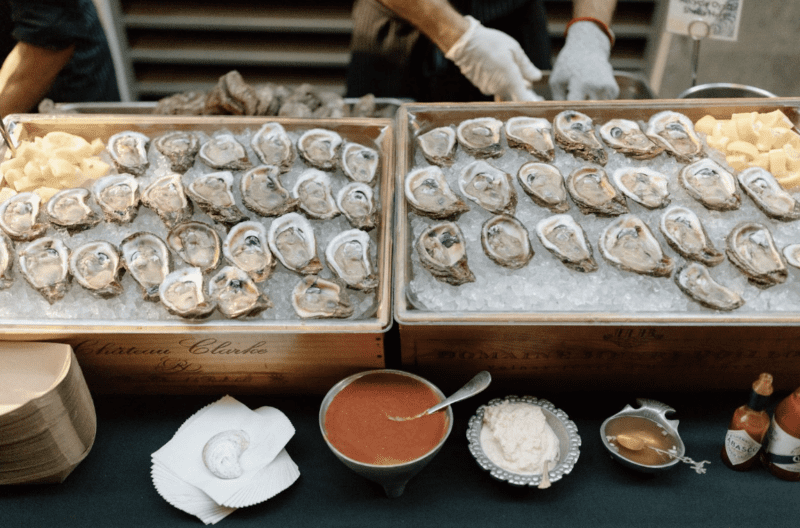Are you interested in learning more about different types of gumbo? This classic New Orleans dish has a cultural history as rich as its flavor. Gumbo has gone through many evolutions over the centuries, so there are plenty of gumbo recipes to explore!
A Brief History of Gumbo
Cultural Influences
So, how did so many different types of gumbo come to be? According to the Southern Foodways Alliance, gumbo has a layered history and draws inspiration from many different cultures. The word gumbo itself, according to Stanley Dry, “derives from a West African word for okra,” which happens to be a key ingredient in many historical and present-day gumbo recipes. Meanwhile, the roux in gumbos—which acts as a thickener—has French origins.
Though okra was and continues to be a vital component of gumbo, once the dish arrived in the United States, some chefs began to substitute filé for okra. The use of filé in gumbo recipes is attributed to the Choctaw tribe, though other Indigenous peoples may have adopted this practice, too.
Origins in New Orleans
It’s no wonder why gumbo has become synonymous with New Orleans’ culinary culture. After all, the first recorded instance of gumbo consumption was at the New Orleans governor’s reception in 1803. However, it wasn’t only the rich and powerful who enjoyed gumbo’s hearty flavors; people of all classes enjoyed the Louisiana dish.
Several centuries-old cookbooks have detailed what ingredients chefs used to craft their gumbos. According to La Cuisine Creole, a cookbook published in 1885, gumbos could contain ingredients as varied as chicken, ham, beef, oysters, shrimp, and crab. The Picayune’s Creole Cookbook, published in 1901, added that they could also feature meats like turkey, rabbit, and veal. Nearly all recipes, however, agreed that any good gumbo requires a roux made of flour browned in oil or another fat.
Types of Gumbo Today
Since 1803, Louisiana has seen the rise of many different types of gumbo. But what is it, exactly, that makes them different from each other? The answer is more complicated than one might think. There are a variety of ways to categorize gumbos!
Seafood Versus Non-Seafood
In the present day, it is most common to see gumbos divided based on whether or not they integrate seafood into their recipes. Frequently, seafood gumbos include oysters, shrimp, or crabs as their primary source of protein. Meanwhile, the most well-known type of non-seafood gumbo is chicken and sausage gumbo, which features andouille sausage.
Not all gumbos can be categorized so easily as seafood or non-seafood. Some recipes happen to feature ingredients from both categories! Alternatively, some gumbos defy categorization by not implementing any type of meat. Gumbo z’herbes is an excellent example of this. Though some cooks add meat to their gumbo z’herbes—or green gumbo—this recipe primarily gets its flavor from vegetables and other greens and is often made vegetarian. For that reason, it is a favorite amongst Louisiana Catholics during the Lenten season since Lent is a period in which many Catholics abstain from eating meat. Even for those not celebrating Lent, green gumbo is an excellent vegetarian alternative to most traditional gumbos!
Okra Versus Non-Okra
The New York Times writes that one of gumbo’s defining features is that it “is much denser than a simple soup; the broth has a thick, almost viscous consistency.” The roux creates a thick texture that services as the base of the gumbo. Once it’s made, you can add okra or filé, which is powdered dried sassafrass leaves, for extra flavor. Most recipes leave it up to the individual chef whether they prefer to use okra or filé as their thickener, though okra is far more common. Many modern chefs craft their gumbo using a brown roux as the sole thickener, eliminating the need for filé. As such, this is more of a historical way of categorizing recipes than a modern means.
Tomato Versus No Tomato
Tomato or no tomato? That is the question. And a deeply contested one, too—as it turns out, most gumbo lovers have strong opinions on whether tomatoes have any place in their meal. In this way, the culture surrounding tomatoes’ presence in gumbo is very similar to jambalaya.
According to Southern Living, this typically stems from whether a Southerner was taught to cook based on Cajun or Creole traditions. Cajun gumbo does not include tomatoes, whereas Creole does. It is also worth noting that Cajun recipes typically call for chicken and sausage as their protein sources, whereas Creole recipes most often opt for shellfish. Even still, there are always bound to be a few exceptions to the rule.
Why You Should Cater Gumbo for Your Next Celebration
If you are hosting an event in New Orleans and want to embrace the city’s culinary history, then gumbo is the perfect choice for catering! Given the different types of gumbo available, you will surely find an option that appeals to you and your guests.
We at Elysian Events Catering would love to use our extensive experience in the service industry and love of Louisiana’s culture to cater your next event, New Orleans-style. We offer a variety of ways to sample our delicious gumbo recipes.
Chicken and Andouille Gumbo and Shrimp and Andouille Gumbo
Our chicken and andouille and shrimp and andouille gumbo recipes are made with roasted okra. These tasty options are available in our wedding catering packages as main entrees.
Our gumbos are also available through our Creole rice bar! This is one of our station options, and it is available to all clients, no matter what kind of event you seek to host. By choosing our Creole rice bar, you can customize what dishes will be served with the rice. The aforementioned chicken and shrimp gumbos are both on the customization list.
Seafood Gumbo
Our rich seafood gumbo is made with shrimp, crab, and oysters, making it a delectable option for seafood fans. This gumbo is available through Wedding Options Two and Four for clients hosting weddings as a premium entree.
But our seafood gumbo isn’t just for weddings! Although it does not appear in our pre-made corporate and private catering packages, we are always happy to create custom menus for our clients. As such, if you would like to provide seafood gumbo to employees at your next work convention or to all your friends and family at a birthday party, let us know through our contact form. Together, we can put together a unique menu tailored to your tastes!
While we currently do not have any vegetarian gumbo options, we pride ourselves on accommodating guests’ preferences, so we will work with you to build a gumbo that works for you and your guests.
Have a Different Favorite Gumbo that isn’t on Our Menus?
That’s not a problem at all! If you have a favorite dish that does not appear on our full menu, let us know in our contact form, and we will see what we can do to accommodate your preferences. This is also a great way to ask for substitutions and accommodations if you or your guests have dietary restrictions.
Elysian Events is Proud to be a Part of New Orleans’ Gumbo History
At Elysian Events Catering, we are dedicated to sharing our love for traditional Southern cuisine with our community, no matter the occasion. Regardless of where your gumbo preferences lie (whether you love or hate tomatoes, we won’t judge), we hope to share our passion for delicious New Orleans cuisine with you. To learn more about our catering services and book Elysian Events Catering for your next event, reach out to us using our contact form. We can also be reached by email or phone at (504) 541-009.





